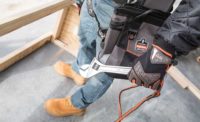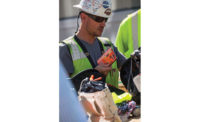Dropped tools and equipment are some of the deadliest hazards from working at height that often go overlooked. New developments and standards are bringing more focus to this hazard in general, but is your company maximizing the benefits of a dropped objects program?
Are you doing all you can to support workers at height?
No matter what your experience with dropped objects prevention, there are some things you can do to enhance safety at heights – and below.
1) You need a program
In 2016 there were 255 fatalities and 47,920 injuries caused by falling objects in the U.S. (Bureau of Labor Statistics). The 2018 Liberty Mutual Workplace Safety Index projects that the cost of worker compensation claims due to falling objects will total $5.3 billion for the year. It's a deadly and costly problem that can be mitigated by the inclusion of a well-developed dropped objects program.
2) You need to be aware
Awareness of potential dropped objects hazards on a worksite is a key step. Have you identified the risk areas for dropped objects at your workplace?
For some companies it's very straight forward; there are locations where work will be performed at height and those are the areas where dropped objects may become a problem. For other companies working multiple sites or with constantly changing conditions, the problem can be a little more complex as the risk areas move over the course of the day or as work progresses.
Companies with well-developed programs understand not only where an object may fall, but also how far it might ricochet in the event of an impact, and in turn can take measures to prevent workers from inadvertently entering falling objects zones.
3) Maximize the benefits of your tools
The new ANSI/ISEA 121-2018 standard has provided clarity on which products to use, but it also has provided four clear-cut categories of products.
Tool Tethers: Tool tethers are one of the most recognized pieces of a dropped objects prevention system. They connect a tool to an anchor. Tool tethers are straps of fabric with connectors on the ends. Make sure your tethers have a standard max tool weight rating and that the carabiner and snaphook style connectors have locking gates and captive eyes.
If your workplace is ahead of the game, and has already adopted ANSI’s specifications, these requirements will already be incorporated into the product. Some additional improvements to get the most out of your dropped objects prevention program include providing the shortest length lanyard practical for the type of work being done, keeping tether materials as low profile as possible to prevent snags, and having some form of swivel to avoid tangling.
Anchor Attachments: Anchor attachments are points to which an object is tethered to arrest it in the event it is dropped. Many times, anchors are fixed structures and can be railings, I-beams, scaffolding, or other elements of a building capable of absorbing the impact of a dropped tool.
Anchors for dropped object prevention are often different than anchors for fall protection in that sometimes for dropped objects prevention, the workers themselves become the anchor to which an object is tethered. Any dropped objects prevention product that creates an attachment point on the worker is considered an anchor attachment.
For example, if you're using a wrist cuff to attach a tool and tether to your yourself, the cuff is an anchor attachment. If you're connecting a tethered tool pocket to your harness, the pocket becomes the anchor attachment. To maximize the benefits of your dropped objects prevention program, limit the overall number of items attached to a worker, and always attach to structures whenever possible.
Tool Attachments: Tool attachments are affixed to tools to provide a place for a tool tether to be attached. They are probably the most diverse type of product in the dropped objects prevention system because there is such a wide variety of tools that might be used at height. The best advice to maximizing the benefit from this category of product is to keep a wide variety of tool attachments in stock to allow each worker at a jobsite to choose what works best for them.
Containers: Containers are the last of the four major categories of dropped objects prevention products. They serve two major functions: to hold items that don't lend themselves to tethering, such as hardware, components, consumables, etc., and to serve as a storage location for equipment when it's not actively in use.
For example, when a worker is finished using a tethered hammer, they may disconnect it from the anchorage and store it in a tool bucket. There is still a need to prevent both hardware and stored tools from dropping so a dropped objects prevention system should always include some manner of containment.
4) Get to work
If you’re not yet aware of the hazards presented by dropped equipment, get familiar. If you are aware of the problem and not doing enough to mitigate the hazards, start doing so. A good understanding of the four categories detailed in the new ANSI/ISEA 121-2018 combined with heightened hazard awareness and the dedication to prevent injuries will go a long way toward maximizing height safety on your jobsite.









